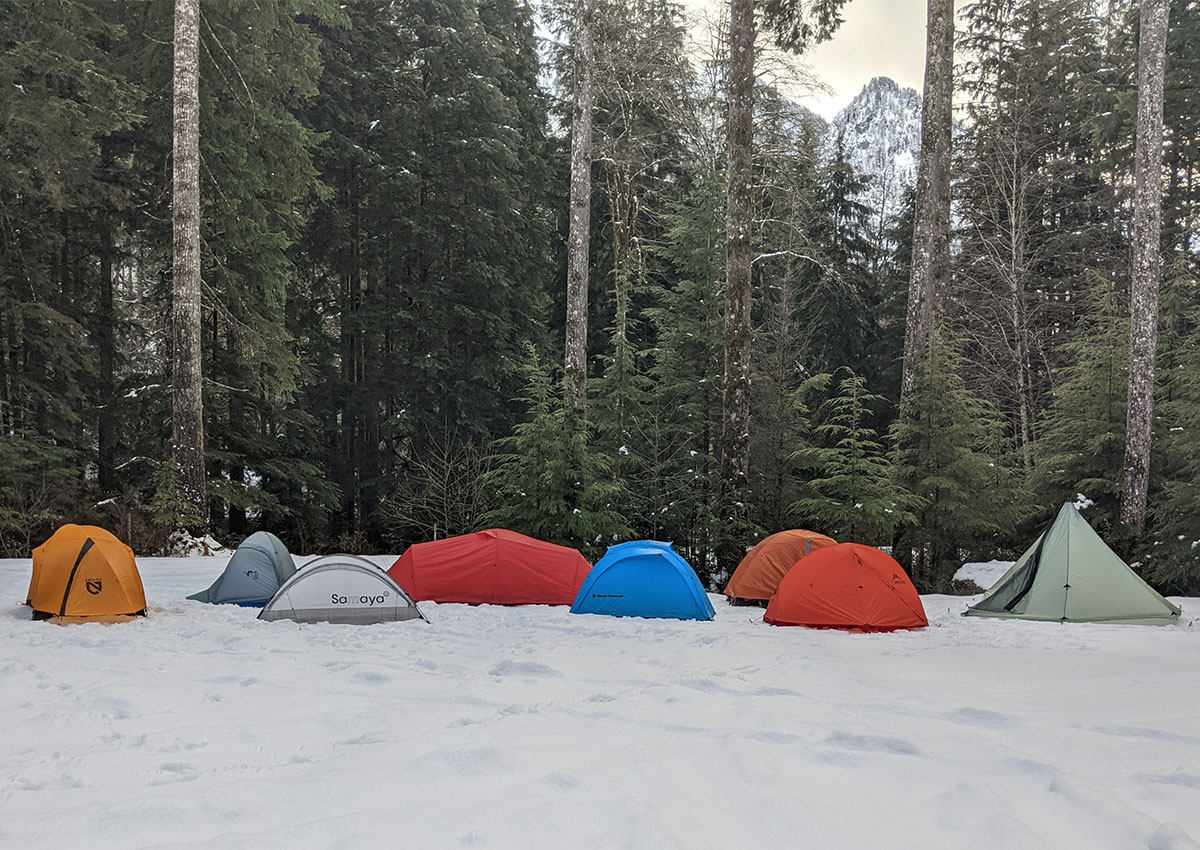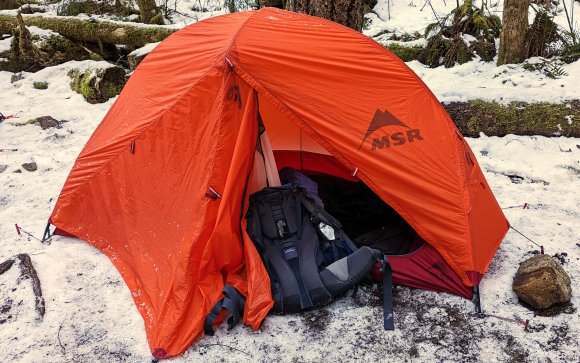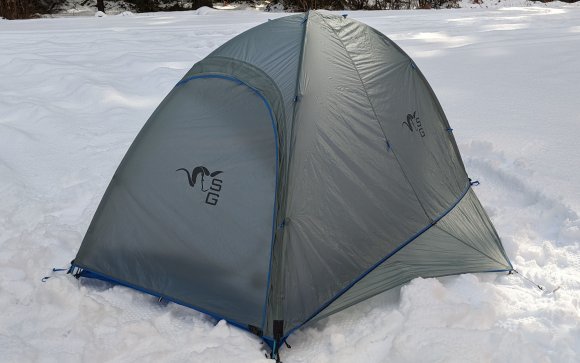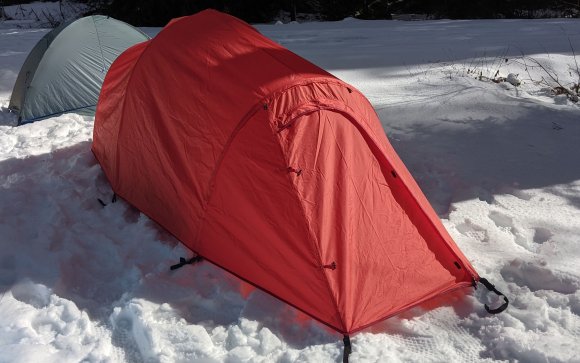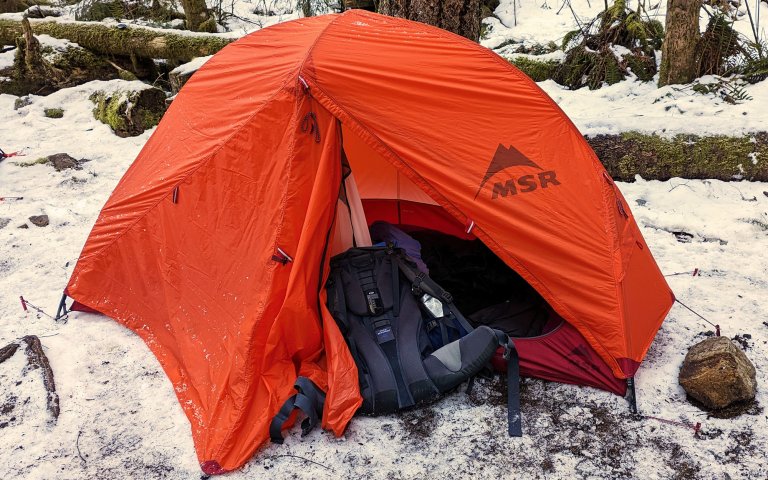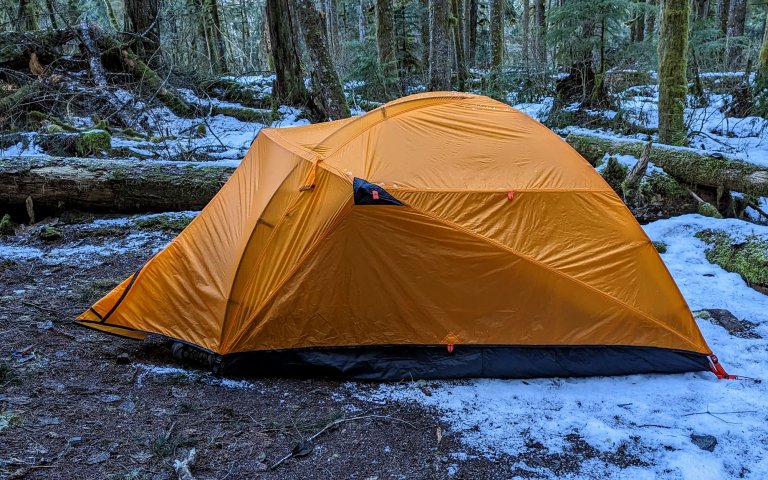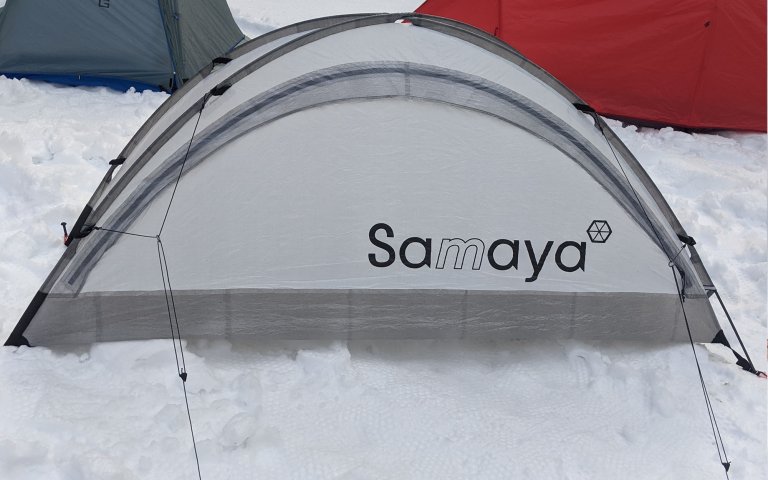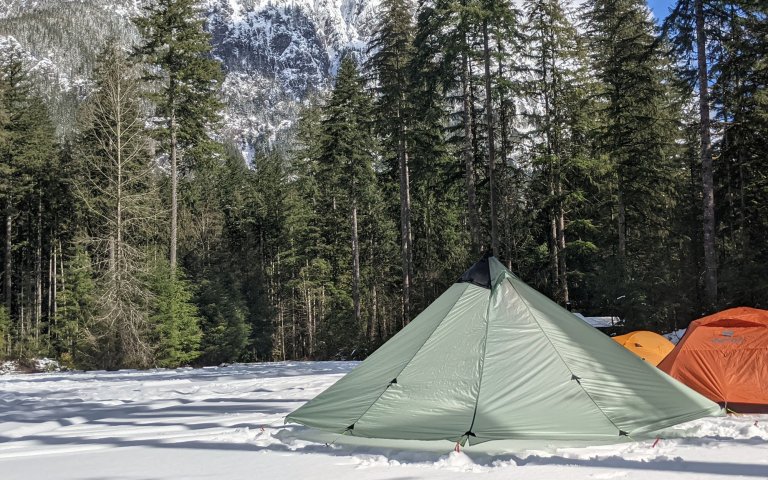We may earn revenue from the products available on this page and participate in affiliate programs. Learn More ›
There is no piece of gear friends ask to borrow more than my 4-season tent. And trust me, I get it: 4-season tents, or winter-season tents, are both expensive and rarely used compared to their three-season counterparts. But if you’re ready to up your shoulder season and winter explorations, it’s time to make the investment. I took a look at some of the best 4-season tents on the market—at a variety of price points—to help you choose the newest addition to your gear closet.
Best Overall: MSR Access
↓ Jump to Review
Best for Bad Weather: Stone Glacier Sky Solus
↓ Jump to Review
Best for Mid-Shoulder Season: NEMO Kunai
↓ Jump to Review
Best Single-Wall: Black Diamond Hilight
↓ Jump to Review
Best for Single Day Expeditions: Samaya Radical1
↓ Jump to Review
Best Non-Freestanding: Seek Outside Cimarron
↓ Jump to Review
Best Budget: Alps Mountaineering Tasmanian
↓ Jump to Review
Testing the Best 4-Season Tents
One of the biggest obstacles facing first-time winter tent buyers is cost. Four-season tents are typically more expensive than three-season tents, even though they are likely to get less use. To start, I looked for tents that were suitable for below or at tree line, as opposed to more expensive expedition or mountaineering tents, aiming to find options at a variety of price points.
I first set up all the tents in my home to get a feel for how easily they went up and came down before taking them into the field. All tents were set up in winter conditions to assess how they performed in the snow, and several were also used on winter camping trips.

After each tent was set up, I spent time inside of them to assess how much warmth they were keeping in, and to get a feel for what the interior space would feel like for one or more people and their gear.
Since testing was originally completed for this story, the Marmot Fortress, my original best budget pick, has been discontinued.
The Best 4-Season Tents: Reviews & Recommendations
Best Overall 4-Season Tent: MSR Access
Best Overall
MSR Access
See ItPros
- Virtually no condensation
- Comparatively lightweight
- Great stuff sack
- Easy setup
Cons
- Expensive
- Somewhat delicate materials require care
Key Features
- Materials: 20D ripstop nylon and Easton Syclone composite poles
- Floor Dimensions: 29 square feet (for a two-person tent)
- Includes eight stakes and four guylines
- Doors: 1 to 2
- Vestibules: 1 to 2
- Weight: 3 pounds, 10 ounces (for a two-person)
The MSR Access is extremely lightweight for a winter tent. It sets up easily with little fiddling to achieve a taut structure and had almost no condensation problems during testing. The lack of condensation is especially impressive given that nighttime temps dropped into the low twenties and the used had a hot water bottle stashed in the bottom of her sleeping bag. The temperature differential between the inside and the outside of this tent was substantial, yet moisture did not accumulate.

Unusually, the MSR Access achieves this exceptional ventilation with only one tiny window. The body of the tent itself—20D ripstop nylon—is breathable, helping the moisture generated inside your tent move to the exterior of the fabric. The rainfly’s design maximizes airflow by pushing moisture-laden air from inside the tent to the outside.
MSR’s Access was impressively easy to assemble. On the testing trip, my friend set up her Access before I finished with the NEMO Kunai. And, as winter tents go, this one is fairly easy to get into bombproof shape. S take out the vestibule and give the cinch cords at the ends of the rain fly a few tugs, and you’re good to go. I also liked that the MSR Access has guyline cords pre-attached to the tent. Even if they aren’t strictly necessary to use on your average winter backpacking trip, it’s not something you want to fiddle with too much if conditions turn dicey.

One small detail that made a big difference is the design of the MSR Access’s stuff sack. While most tent stuff sacks are longish cylinders with top openings, the MSR Access is a longish cylinder with a large wide side opening. This made packing away a wet tent a breeze, and saved both my and my tester’s fingers from getting unnecessarily cold during the quick cleanup to leave camp.
Best for Bad Weather: Stone Glacier Sky Solus
Pros
- Very roomy interior
- Design details make this easier to set up in bad weather
- Protected side vestibules
Cons
- No large vestibule for your backpack
Key Features
- Materials: 15D ripstop nylon and DAC 10.65mm PL poles
- Floor Dimensions: 24.5 square feet (for a one-person tent)
- Includes 14 stakes and 14 guylines
- Doors: 1
- Vestibules: 2
- Weight: 4 pounds, 6 ounces (for a one-person tent)
No one plans to get stuck in their tent during a winter storm, but if it was going to happen to me, I’d want to be in the Stone Glacier Sky Solus. First off, for a one-person tent, it’s exceptionally roomy. Just about everyone will be able to fit not only themselves (the diagonal measurement is well over seven feet), but also the majority of their gear inside the tent with them.

It also takes an unusual approach to the vestibules. Rather than having a single vestibule outside the door of the tent, it has two smaller ones on the sides of the tent. You can access these from inside the tent via a cinch-cord opening. They aren’t massive vestibules—big enough to stash the best hiking boots or backpacking rain jackets—but it’s enough to hold anything you don’t want in the tent with you, and they are very protected from the elements by the low-lying rainfly. Generous mesh pockets provide additional storage options on the inside of the tent.

The sides of the tent are protected enough that you could conceivably leave the access points to the vestibules open for extra ventilation overnight. An additional cross-breeze can be obtained by partially opening the door to the tent and a third, small opening at the back of the tent. (When packing up this tent at the end of your trip, ensure the cinch cords are pulled closed from the inside.)

Even the setup of this tent takes the challenges of stormy conditions into consideration. There are two fabric sleeves for the poles that can be unhooked from the body of the tent. This means that in exceptionally bad weather, you could assemble your poles and slot them criss-cross into the sleeves, providing extra stability before you battle the winds to attach the fabric body of the tent.
Best for Mid-Shoulder Season: NEMO Kunai
Best for Mid-Shoulder Season
NEMO Kunai
See ItPros
- Plenty of vented windows
- Fairly lightweight
- Generous vestibule for its size and weight
- Easy setup
Cons
- Prone to excessive condensation
- No included guylines
Key Features
- Materials: 15D ripstop nylon and DAC Featherlite aluminum
- Floor Dimensions: 26 square feet (for a two-person tent)
- Includes six stakes and no guylines
- Doors: 1
- Vestibules: 1
- Weight: 4 pounds, 5 ounces (for a two-person tent)
It happens to the best of us; we’re headed out for what we thought was a late summer or early fall adventure—the last hurrah before a white layer coats the higher elevations—when an early season snow hits. Always fun staying up half the night punching snow off the top of your three-season tent.
If this is happening to you regularly, then the NEMO Kunai could be the tent you need. It bills itself as a three to four-season tent, and it is exactly that, something in-between seasons. It’s not the tent you want for the height of summer, and it’s not the tent you want in the depths of winter, but it excels at the in-between time frame when you’re not quite sure what to expect.

Like other NEMO products, setup is fairly straightforward—if you’re an experienced backpacker then you can get away with setting this up for the first time out in the field (as I did). The one hiccup you may run into is the lack of stakes and guylines. Only six stakes are included (four for the four corners of the tent and two to pull out the vestibule), and the only ropes that could be used as guylines (no tensioners) are attached to the body of the tent, not the rainfly. In mild, tree-sheltered conditions, you can achieve a taut structure with just what’s provided, but if you expect weather then consider purchasing additional stakes and moving the guylines to the rainfly.
What gives this 4-season tent its inter-seasonal bonafides is the sheer number of windows inside: two large windows at the side and one medium window at the back plus the door at the front. With all of these rolled down, you get significant airflow, perfect for unexpectedly warm nights. But if conditions take a turn and temperatures plunge you can zip them right up and get the bombproof protection you need to sleep through the night.

The only catch here is that condensation inside this winter tent can get pretty serious if the windows are rolled up. On an overnight when temps dropped into the low twenties my partner and I woke up to find the body of the tent soaked to the touch (with the exception of the foot of our camping quilt, our gear was dry). I had the top window open, and part of the door, but in the future I would likely leave all of the windows open to prevent excessive buildup of moisture.
Best Single-Wall 4-Season Tent: Black Diamond Hilight
Best Single-Wall
Black Diamond Hilight
See ItPros
- Lightweight
- Great tension, even without stakes
Cons
- Difficult to set up
- Vestibule must be purchased separately
Key Features
- Materials: 30D polyester fabric and aluminum poles
- Floor Dimensions: 27 square feet (for a two-person tent)
- Includes eight stakes and four guylines
- Doors: 1
- Vestibules:
- Weight: 3 pounds, 15 ounces (for a two-person tent)
With summer backpacking, there’s always a chance that you won’t need the rainfly—just a simple mesh enclosure to keep out the bugs. But that’s not the case in the winter. Even if bluebird skies are in the forecast, you’re going to put up the fly to protect you from icy winds and to provide an extra boost of warmth overnight. So why even have a separate mesh body?

The single-wall Black Diamond Hilight (available in both the two- and three-person models) takes this to its natural conclusion, and saves on weight in the process. The two-person version of this tent is under four pounds, which is exceptionally light for a winter tent. It’s also impressively sturdy. During testing, this was one of the few 4-season tents that needed no stakes or guylines to achieve a taut setup, which is important if you’re looking at serious winds or snowfall. Though notably, it doesn’t have a vestibule, which makes it virtually impossible for two people to share the two-person version of this winter tent. However, one can be purchased separately.

Unusually, the poles for the Black Diamond Hilight are set up inside the tent, rather than outside. While theoretically this might allow you to stay dry during setup, in practice this design proved to be a hassle. First, to get both poles into the tent, you’ll need to leave the door unzipped long enough to push them into the metal grommets at the four inside corners of the tent. Experienced users will be able to do this fairly quickly, but it will still leave the interior of your winter tent exposed for longer than it would be with an exterior pole design. Once you’ve done that (and zipped up the tent to keep out the elements), you’re still likely to find yourself covered in folds of fabric until you push the tent poles up into place and secure them with the velcro straps. Needless to say, I recommend practicing the setup of this 4-season tent a few times before taking it out into the field.

Because of its single-wall design, this 4-season tent handles ventilation differently than other models I looked at. At the top of the tent is an arched dome held in place by four stiff (but pliable) rods, with two small vents underneath. The door, which has a small overhang, can also be unzipped to allow for additional airflow, as can a half window on the opposite side of the tent.
Packing away this winter tent has some minor challenges to it. The rods holding the dome for the top vents get in the way when trying to roll up the tent (they are also difficult not to bend out of place in the process). I initially liked that the stake bag was attached to the interior of the pole bag, but in practice found that it was difficult to put everything away without something slipping out accidentally.
Best for Single Day Expeditions: Samaya Radical1
Best for Single Day Expeditions
Samaya Radical1
See ItPros
- Extremely lightweight
- Sets up fast
- Low packed weight
Cons
- Very expensive
- No space for gear inside the tent
- No ventilation
Key Features
- Materials: Dyneema composite and Easton carbon ion poles
- Floor Dimensions: 15.1 square feet (for a one-person tent)
- Includes eight stakes and four guylines
- Doors: 1
- Vestibules:
- Weight: 1 pound, 7 ounces (for a one-person tent)
OK, so I know I said that this story was going to focus on 4-season tents suitable for lowland camping at approachable price points, but here’s the thing about the Samaya Radical1: Its structural integrity given its weight (just a pound and a half) is in a class by itself. Even if this isn’t the winter tent for you (and it probably isn’t), it should at least be on your radar.

First let’s talk about what this tent is not for: This is not the best tent for winter camping when you’re planning a casual trip. It shouldn’t even be your primary tent for a true mountaineering expedition. This tent was designed for alpinists on their last push to the summit. If things go well, they won’t even take it out of their backpack. If the weather turns (or if they run across another climber in distress), then voila: a true freestanding tent, with the chops to protect you from the elements. But there are plenty of backpackers and hunters, too, who head out planning to eschew tenting entirely, whether it’s because they intend to cowboy camp or make it back to the trailhead before nightfall. And that, sometimes, does not go to plan, for all kinds of reasons. This tent is a true emergency shelter for inclement environments—well beyond what you would get from a simple rigged-up sheet of Tyvek for essentially the same weight and packed size.

So what does it take to get the weight of a 4-season tent this low? It starts, of course, with getting rid of everything that isn’t a tent. That means no vestibules, no windows or vents, and no pockets on the interior. Even the square footage of the inside of the tent has been reduced to the bare minimum. I could lie down inside of this tent, but someone over six feet is going to start running into the edges.

Next is to use the lightest materials possible that still provide the necessary strength for extreme conditions. The poles are made from carbon fiber, a material that is exceptionally delicate (do not step on these poles by accident), but when linked together and inserted into the tent sleeves can withstand very strong winds. The body, similarly, is made from Dyneema with an ePFTE membrane. While the included guylines (pre attached to the tent) have plenty of reach, they are made from a thinner cordage than other tents I looked at and had somewhat fiddly (although very effective) tensioners. Even the eight tent stakes, Swiss Piranhas, are impossibly lightweight, weighing just .1 ounce each. But they had plenty of holding power in snow—more than many of the more robust models I looked at.
If you regularly find yourself far from the trailhead on daylong expeditions in dicey conditions, then the Samaya Radical1 is a worthy (if expensive) shelter to add to your arsenal.
Best Non-Freestanding: Seek Outside Cimarron
Best Non-Freestanding
Seek Outside Cimarrron
See ItPros
- Massive interior living space
- Very lightweight
- Can be paired with a lightweight titanium stove
Cons
- Expensive
- No floor
- Requires skill and experience to use
Key Features
- Materials: 30D silnylon and carbon fiber pole
- Floor Dimensions: 94 square feet
- Includes six cyclone stakes, six Y stakes, and three guylines
- Doors: 1
- Vestibules:
- Weight: 3 pounds, 8 ounces
Freestanding tents are considered the gold standard in backpacking—easy to use and understand, and considerably more stable for beginners than their non-freestanding counterparts. But they are also typically heavier. Both of these differences are taken to their extremes in winter tents. The weight to size ratio you can achieve with a non-freestanding is truly impressive—the Seek Outside Cimarron was far and away the lightest tent I looked at givens its square footage—but your skill level at pitching your tent needs to be top notch.

I’ve used non-freestanding tents for backpacking for years, but never for winter camping. In my experience, it’s basically inevitable with a non-freestanding tent that at some point one of your stakes is going to get kicked up by an unusually strong gust of wind—if that happens to enough stakes your tent collapses on you and you need to spend a few minutes outside dealing with the situation. The more you use your tent, of course, the less this happens, but it can be a steep learning curve.

The Seek Outside Cimarron is no different: If the stakes come out, this tent is going down. Fortunately, Seek Outside included some serious stakes. They’re ten inches of twisted aluminum (essentially identical to the MSR Cyclone design). While these stakes will still struggle to find purchase in a foot of soft powder or ground that is frozen solid, they will hold just fine in just about anything in between.

Once your stakes are in the ground, it’s just a matter of assembling the meaty but lightweight carbon fiber pole and extending it upward into the top corner of the tent. Once it’s in place, you can use the additional holes on the top section of the pole to extend it higher up, increasing the tension on the fabric body of the tent. While I recommend watching the accompanying video showing how this works on Seek Outside’s website, in practice it’s more straightforward than one might expect.
While the Cimarron is expensive, it’s versatile enough to work as both a summer and winter tent—a true 4-season tent. You can also pair this tent with the Seek Outside titanium stove, which Outdoor Life tested as part of our look at the best hot tents.
Best Budget 4-Season Tent: Alps Mountaineering Tasmanian
Best Vestibules
Alps Mountaineering Tasmanian
See ItPros
- Affordably priced
- Great vestibules
- Roomy interior
Cons
- Heavy
- Time-consuming to pull taut
Key Features
- Materials: 75D polyester and 7000 series aluminum poles
- Floor Dimensions: 34.5 square feet (for a two-person tent)
- Includes 16 stakes and six guylines
- Doors: 2
- Vestibules: 2
- Weight: 7 pounds, 15 ounces (for a two-person tent)
Winter camping—whether you are backpacking, ski touring, or hunting—means extra gear, sometimes a lot of extra gear. And most of it—snowshoes, crampons, boots—is expensive. And it can’t really come inside the tent with you. So an affordably priced winter tent with healthy-sized vestibule should be high on your list of considerations.

The vestibules of the ALPS Mountaineering Tasmanian are massive–easily the biggest of any winter tent I looked at. It’s also about half the price of the options on this list. Either of the two vestibules could have easily held all the excess gear for two people. The extra square footage comes from a separate pair of poles that hook into each corner of the tent and then thread through the rainfly itself, pushing it outward. (I promise in practice this was fairly simple to set up.) The result is so much extra space that not only could you store all your gear with room to spare here, you could also suit up in the vestibule before opening up the rainfly to meet the elements.

The ALPS Mountaineering Tasmanian also had the most interior square footage of any two-person tent I looked at; two large people over 6 foot 5 inches would easily fit inside this 4-season tent with room to spare. Of course, the downside to all this extra space is that this is a very heavy tent—about twice the weight for two people as my best overall pick.
While this winter tent was reasonably easy to set up, I found that it took more effort than with other models to achieve a taut, storm-ready profile. Plan to set this one up in your backyard a few times before taking it out into the field.
How To Choose the Best 4-Season Tent
Size
When choosing a 4-season tent, consider the gear you are planning to bring with you and compare that against the square footage of the tent, including vestibule space. Like with three-season and camping tents, there is a lot of variation in what is considered a one-person or two-person tent.
Ventilation
One of the biggest issues winter backcountry travelers face is condensation, when moisture collects on the inside of the tent. While condensation can occur at any time of year, it is a bigger issue in winter due to the lower nighttime temperatures. Choosing a tent with proper venting can make a big difference in the comfort of your trip.
Weight
The reality is that your winter and late shoulder season tent is going to be heavier than your regular backpacking or hunting tent—expect to carry about twice the weight you normally would, at a minimum.
Material Strength
Part of the reason winter tents are heavier is that they need to use more robust material—heavier poles, thicker tent floors, more robust rainflys. The strength of the materials, in combination with the overall design of the tent, is what allows them to withstand the stronger winds and heavy snowloads that can occur during winter adventuring.
FAQs
Despite the nomenclature, it’s best to think of 3-season tents as best for summer to early shoulder season conditions, and 4-season tents as best for late shoulder season to winter conditions. Of course, when “winter” starts and ends can be pretty subjective. You’re unlikely to need a 4-season tent at any time of the year in Florida, while a summit attempt on Mount Rainier calls for serious protection even in summer.
Another distinction to look at is mountaineering (or expedition) tents versus more standard 4-season tents. Alpinists must be prepared for anything, including unexpected and dangerous weather conditions, and mountaineering tents are built to be essentially bombproof. But that comes at a cost, both in the price of these tents (which can easily run upward of a thousand dollars) and in extra weight. Choose a mountaineering or expedition tent if you plan to be in an exposed part of the backcountry for extended periods of time with little to not recourse to move your camp below the treeline.
To stay warm in a tent in winter you’ll need to first ensure you have one of the best backpacking sleeping pads, rated to a proper R value—look for pads with a rating of 7 or above. Next, choose one of the best sleeping bags or best camping quilts rated to a 10 degrees below what you expect your lowest night time temperature to be (consider going 20 degrees lower if you run cold). While the inside of winter tents can be as much as 10 degrees warmer than the outside air, this boost should not be relied upon.
You can sometimes get away with using your regular backpacking tent in winter, as long as you can be certain that you won’t face adverse conditions, like significant snowpack or heavy winds, which can snap poles. If you are uncertain about whether your current tent will work on your planned trip, reach out to the land management administration, which will be able to offer advice on adverse conditions.
Winter tents are absolutely worth the cost if you are heading into the backcountry in winter year after year. It will keep you warmer, protect you from extreme weather events, and provide additional space for bulky winter gear like snowshoes or skis, extra clothes, and burly rain gear.
Final Thoughts
There is a surprising array of the best 4-season tents, at different price points and offering different levels of protection to meet a variety of needs. If you’re hoping to get out more into the later shoulder season or during the winter, then consider what types of trips you’re likely to take and then search out a tent that would be appropriate for those conditions at the lowest price point and weight that you can manage.
- Best Overall: MSR Access
- Best for Bad Weather: Stone Glacier Sky Solus
- Best Vestibules: Alps Mountaineering Tasmanian
- Best for Mid-Shoulder Season: NEMO Kunai
- Best Single-Wall: Black Diamond Hilight
- Best Budget: Marmot Fortress
- Best for Single Day Expeditions: Samaya Radical1
- Best Non-Freestanding: Seek Outside Cimarron
